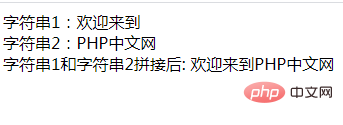Home >Backend Development >PHP Problem >What does '.' in php mean?
What does '.' in php mean?
- 青灯夜游Original
- 2021-09-09 19:30:1010145browse
The dot "." in php means "connection", which refers to the string connector, which can be used to splice two or more strings together to form a new string. ;The specific syntax format is "$string = string1.string2.string3.······.stringN;".

The operating environment of this tutorial: windows7 system, PHP7.1 version, DELL G3 computer
In php, click ". " refers to the string concatenation character, which can splice two or more strings into a new string.
The specific syntax format is as follows:
$string = string1.string2.string3. ······ .stringn;
Example:
<?php
header("Content-type:text/html;charset=utf-8");
$str1="欢迎来到";
$str2="PHP中文网";
$str3=$str1.$str2;
echo "字符串1:".$str1;
echo "<br>字符串2:".$str2;
echo "<br>字符串1和字符串2拼接后:".$str3;
?>Output result:

Instructions: When using echo to output a string, you can also use curly brackets {$str} to embed variables in the string, such as "literal{$str}literal"; if you do not use { } You can also use word segmentation characters to separate variables and text. Word segmentation characters are generally spaces, punctuation marks, etc.
<?php
header("Content-type:text/html;charset=utf-8");
$str1="欢迎来到";
$str2="PHP中文网";
$str3=$str1.$str2;
echo "字符串1:".$str1;
echo "<br>字符串2:$str2";
echo "<br>字符串1和字符串2拼接后: {$str3}";
?>Output result:

In javascript, we can use " " to splice strings, but in PHP, the " " sign can only do arithmetic operator, but cannot be used as a string operator; then can only the "." operator be used to concatenate strings? No, you can also use the assignment operator ".=". The
.= operator appends the characters on the right to the left. Its syntax is:
$string = string1; $string .= string2; $string .= string3; ······ $string .= stringn;
Recommended learning: "PHP Video Tutorial"
The above is the detailed content of What does '.' in php mean?. For more information, please follow other related articles on the PHP Chinese website!

